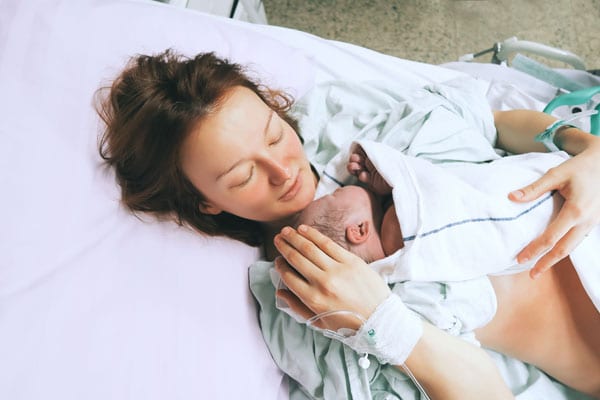Stay up-to-date. The situation with COVID-19 is changing constantly and so are policies and guidelines. Consult trusted sites, such as the resources listed below, to keep up-to-date on the most current advice for pregnant women and new moms. Review your office, clinic, and hospital websites for the most up-to-date information so you can plan for office visits and your stay in the hospital.
Know what to expect at the hospital: Hospitals are changing visiting policies to prevent the spread of COVID-19. Review the website of the hospital where you’re planning to give birth to check their current visitor policies. These are some of the restrictions that may be in place in your hospital:
Screening all visitors and patients before they enter the hospital
- Hospitals are taking temperatures of every patient and visitor when they arrive.
- Patients and visitors will be asked about symptoms of COVID-19, possible exposure to someone with COVID-19, and recent travel.
Visiting policies will vary. You may see these recommendations implemented at your hospital:
- One visitor allowed for women to come to the birth unit (labor and delivery unit). This visitor is usually the only visitor allowed for the entire stay. Some hospitals may not allow visitors.
- No children are allowed as visitors
- Hospitals are limiting visitors from coming and going. Check with your hospital about their policies.
- Check on any restrictions about what you can bring with you to the hospital including food.
COVID-19 Symptoms
Prior to labor and birth, if you have symptoms of COVID-19 contact your healthcare provider for care and follow guidelines for separating yourself. Read What You Should Know About COVID-19 and Your Pregnancy.
- At this time there is no recommendation that birth by cesarean or a labor induction is required if you have COVID-19.
- Women who have COVID-19 are recommended to wait to give birth, if possible, until a negative test result is obtained or they’re no longer quarantined to avoid transmitting the virus to their newborn.
- Check with your hospital if you plan to have a doula or labor coach present in addition to your partner because they may not be allowed under current visiting policies.
- Epidural pain management for labor is an option for women with COVID-19. If you planned on using nitrous oxide in labor check with your hospital to find out if it’s still an option or if its use has been suspended during the pandemic.
- You may be asked to wear a mask over your mouth and nose even if you have no symptoms of COVID-19 to protect all who you come in contact with at the hospital. People without symptoms can have COVID-19 and spread the virus when they talk, cough, or sneeze.
If you’re in labor and have COVID-19, or are suspected of having COVID-19 due to symptoms like fever or cough, call your healthcare provider before going to the hospital. Discuss your labor progress and what to expect when you arrive. You’ll be required to wear a mask to limit the spread of the infection and placed in an isolation room when you arrive on the birth unit.
We don’t know at this time whether COVID-19 can cause serious problems for baby. We don’t have much information on mothers with COVID-19 and whether it’s possible for COVID-19 to be transferred to baby prior to birth. Right now the priority is to keep baby from getting COVID-19 after birth.
If you’ve tested positive or are suspected of having COVID-19 the recommendation at this time is to temporarily separate you and your baby after birth to keep your baby from getting COVID-19. Discuss the risks and benefits of separation with your healthcare provider taking into consideration the severity of your symptoms.
- Your hospital may have a separate isolation room for your baby. If a separate room is not available barriers such as a curtain or room divider can be used to separate your baby by six feet or more. Six feet is recommended to best avoid transmitting the virus.
- A healthy adult should stay with you to help to care for your baby. This person should wear gown, gloves, face mask, and eye protection at all times.
- Mothers who are separated from their newborn and wish to breastfeed are encouraged to express breast milk to maintain supply and have milk available for a healthy caregiver to feed the newborn. So far, the virus hasn’t been found in breastmilk, but it’s unknown at this time if COVID-19 is spread in breastmilk.
- Talk with your healthcare provider about when you’ll no longer need to be separated from your baby. Decisions are made based on your individual case taking into account how your illness has progressed, your symptoms and lab results.
Other points to consider as you prepare for birth
- Postpartum follow-up appointments: Many providers are scheduling telephone or video follow-up appointments. When you go home from the hospital confirm your follow-up appointments and if you’ll have an in-person or a telephone or video appointment.
- Before you go home: Arrange to have your home well-stocked with food and supplies for you and your baby.
- Once you’re home: Let others go shopping for food and any needed supplies. Follow the recommendations for social distancing to decrease your chances of being exposed to COVID-19. Plan virtual visits to introduce your baby to family and friends. Wash hands frequently and disinfect “high-touch” surfaces often. To support your immune system and regain strength, rest as often as you can, drink plenty of fluids, and eat healthy foods. Use your favorite personal strategies to decrease anxiety and stress.
Get the latest news and updates
Centers for Disease Control and Prevention (CDC):
- Pregnancy & Breastfeeding (Review “During Pregnancy or Delivery”)
- Preventing the Spread of Coronavirus disease 2019 in Homes and Residential Communities
World Health Organization:
American Academy of Pediatrics






Comments are closed.